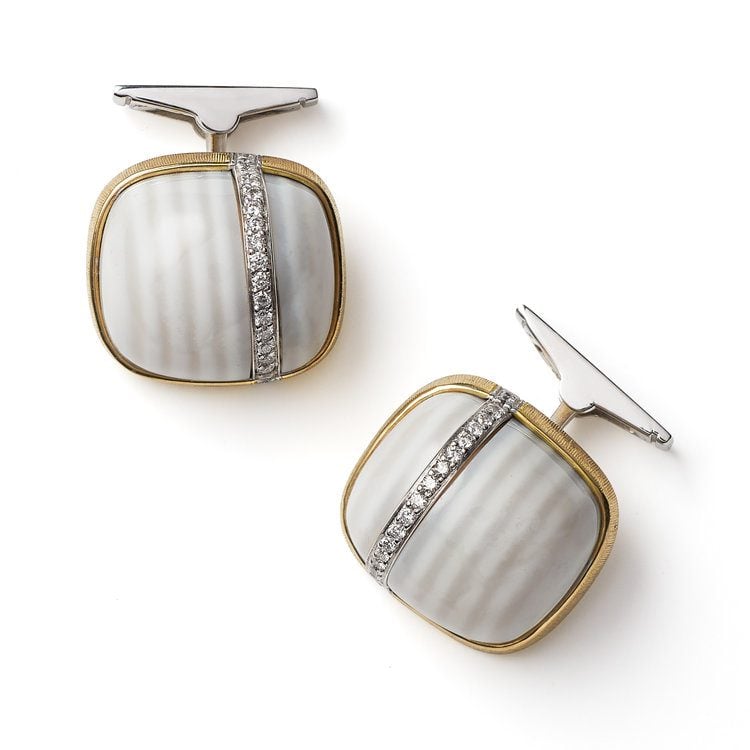Gemstone Cufflinks Guide
Wearing gemstone cufflinks is a great way to add personality and style to a standard tuxedo. Learn how to choose gems for both formal and casual events.
2 Minute Read
Formal and Reserved Gemstone Cufflinks
For black tie events where a tuxedo is not optional, sticking to traditional styles is simplest. Black jade (jadeite or nephrite) is an excellent choice for these occasions and also versatile enough for less formal occasions. Plus, jade is a hard and tough material that is unlikely to scratch or break, requiring little care to keep your cufflinks in prime condition. If jade is out of your price range, black onyx has a similar look at a lower price point and makes a very traditional cufflink gem.
However, black is considered inappropriate for white tie events. For white tie, mother of pearl is your best bet. Cufflinks with its delicate shine make a great addition to any wardrobe. Pearl is another option. With the same delicate sheen but a rounded profile, pearls can add some interest to tuxedos. Mother of pearl and pearl are also appropriate for black tie events. However, these materials are easily scratched. Store them carefully at the end of the night.
Gemstone Cufflinks with Sparkle and Flair
Of course, faceted gems are also an option! Though these are best reserved for evening wear, the sparkle of a well-cut gem can add interest to a tuxedo at any time.
Some of the most popular choices are diamond, sapphire, ruby, and emerald. Jewelry makers often incorporate these gems into designs or patterns on top of more traditional materials, like mother of pearl or onyx. While diamond, sapphire, and ruby are durable enough to resist scratching and chipping under most circumstances, emerald is somewhat fragile and will chip or fracture easily.
Colorful Cabochons, Doublets, and Triplets
Of course, events with a looser dress code offer more room for color and personality. Cabochons are a great way to showcase the beauty of translucent or opaque gems. Furthermore, with the right style, cabochon gems in cufflinks may be appropriate for everyday wear.
Tourmaline and garnet make beautiful translucent cabochon material, and both come in a wide variety of colors. In addition, these gems are hard and durable enough to resist wear. Although best known for red hues, garnets occur in every color. Some may even change color under different lighting sources. The most common variety of gem tourmaline is verdelite, the green variety.
If you're looking for something more unique, a gem with a cat's eye or asterism is sure to attract attention. For another fascinating option, consider an opal with its play of color in a doublet or triplet setting.
Keep in mind that these assembled gems require special care. Also, many opals show their best colors in sunlight. Although doublets have a better aesthetic and higher value, a triplet has a hard top surface resistant to scratching.
Gemstone Cufflinks for Everyday Wear
If you wear jackets and French cuffs frequently, you may want some cufflinks for everyday wear. Matching the color to your tie or socks is a great way to coordinate!
Some gems, such as agate and turquoise, have natural patterns that complement solid-color suits and shirts. On the other hand, gems with solid colors are best for shirts with patterns. Lapis lazuli, with dark blue hues, is an excellent example. Chalcedony, chrysoprase, carnelian, malachite, and hematite also make great options for cufflinks.
If you're looking for a conversation starter, materials like meteorite or gem-grade bone are sure to get people talking. While these unusual gems have an appeal beyond their appearance, they are attractive in cufflinks and other jewelry designs.
Addison Rice
A geologist, environmental engineer and Caltech graduate, Addison’s interest in the mesmerizing and beautiful results of earth’s geological processes began in her elementary school’s environmental club. When she isn’t writing about gems and minerals, Addison spends winters studying ancient climates in Iceland and summers hiking the Colorado Rockies.
Related Articles
Common Gemstone Treatments Cheat Sheet
How to Re-Oil Emeralds Safely and Easily
Do Natural Rubies Fluoresce?
Choosing an Emerald Engagement Ring Stone
Latest Articles
800 Years of Mogok: A Celebration in Tenuous Times
What is the Average Gemstone Faceting Yield?
Pyroxmangite Value, Price, and Jewelry Information
How to Identify Emerald Simulants and Synthetics
Never Stop Learning
When you join the IGS community, you get trusted diamond & gemstone information when you need it.
Get Gemology Insights
Get started with the International Gem Society’s free guide to gemstone identification. Join our weekly newsletter & get a free copy of the Gem ID Checklist!
